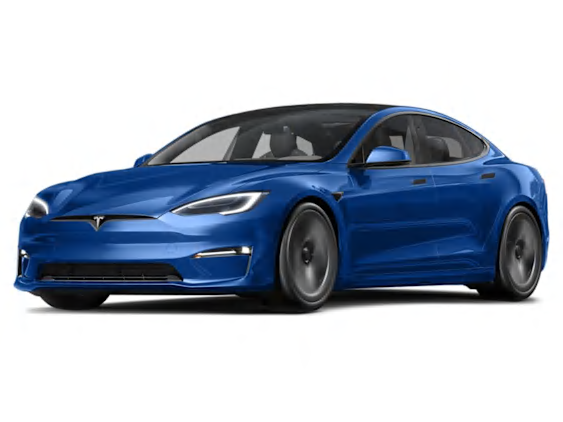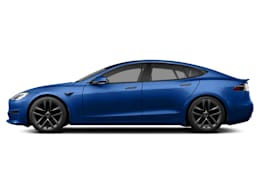The updated Tesla Model S probably would have garnered the highest road-test score we’ve ever recorded if it weren’t for its new yoke-style steering wheel. The yoke—similar to the half steering wheel pilots use to control airplanes—and the other control changes that come with it, bring major compromises in usability, maneuverability, and comfort. It’s a shame, because the fully-electric Model S is otherwise a truly amazing car.
For starters, the Long Range model we purchased is the quickest car we’ve ever tested, scorching from 0 to 60 mph in just 3.2 seconds. The thrilling acceleration from the 670 horsepower is immediate, seamless, nearly silent and, unlike many electric vehicles which lose steam at higher speeds, the power and forcefulness of the Model S just keeps going and going. All-wheel drive is standard, thanks to the two electric motors—one driving the front wheels, the other driving the rears.
The Long Range version has an EPA-estimated 405-mile driving range, which is quite good for an EV. Charge times are long, though, especially compared to fueling a gasoline-powered car, but the Model S’s large battery eliminates the need to charge very often. It took us about 7.5 hours to charge the battery to full from about 30 percent remaining on Tesla’s wall-mounted home charger. The ability to use Tesla's supercharging network—typically found in fairly convenient public places, including highway rest areas—is a huge plus when taking long drives.
The Model S is not only super speedy, but it handles superbly, snaking through our avoidance maneuver—which simulates swerving quickly to avoid a vehicle or obstacle on the road—with outstanding agility, thanks to quick steering and hardly any body roll. It made it through our tight, coned-off course at an impressive 58.0 mph, which is serious sports-car territory.
The ride is firm yet fairly comfortable, as long as buyers stick with the standard 19-inch wheel/tire package as opposed to the optional 21-inch tires.
Although the Model S performed admirably during high-performance driving, the yoke steering wheel proved a constant nuisance the rest of the time. For instance, turns that require hand-over-hand movements—such as pulling into a driveway or parking—leave one of your hands without part of the wheel to hold onto. It’s also extremely difficult to keep both hands on the yoke as you unwind the wheel after taking a turn. In some cases, the yoke simply slipped out of our test driver’s hands, which is dangerous.
Possibly even more egregious is that Tesla eliminated the steering-wheel stalks that typically handle a vehicle’s turn signals, windshield wipers, and high beams, replacing them with touch-sensitive buttons on the yoke. We found that we always had to look down at the wheel to activate these controls, rather than operating them by feel as you would with a stalk. There also isn’t an actual gear selector, mirror-adjustment switches, direct steering-wheel adjustment, or a simple way to redirect the dashboard air vents. All of these functions have to be performed through the main infotainment display screen, and they are impossible to accomplish without looking away from the road.
On the bright side, the front seat proved comfortable and supportive for most drivers. The seatback has ample side bolstering to keep occupants in place and there are plenty of adjustments, including four-way lumbar and the ability to tilt the leading edge of the bottom cushion up and down. Thankfully, those adjustments are via conventional controls on the side of the seat. If not for the yoke steering wheel, the driving position would be excellent, with plenty of headroom, a well-placed left footrest, nicely-padded armrests, and hardly any center console intrusion. But the yoke forces your hands into an uncomfortable—and potentially unsafe—position, causing hand- and shoulder fatigue on some of our drivers.
In spite of the Model S’s relatively large size, the rear seat isn’t very comfortable. Headroom is decent but foot space under the front seats is quite tight, and the seat’s low position to the floor results in a huge knee bend and a complete lack of thigh support. It’s too bad, because the seat is nicely shaped and has the potential to be comfortable.
The car’s low slung stance also makes it awkward to get in and out, though the hatchback design aids versatility, and the front trunk (or “frunk”) is a nice bonus for carrying a small amount of extra luggage.
Forward collision warning, automatic emergency braking with pedestrian detection, lane departure warning, and lane keeping assistance are standard. Instead of a typical blind spot warning system that grabs the driver’s attention by flashing an icon in the side mirrors or at the base of the windshield pillars, the Model S displays images of cars in adjacent lanes on the instrument cluster screen—a poor substitute.
And despite the names of its standard Autopilot and optional $15,000 “Full Self-Driving Capability” features, the Model S doesn’t drive itself, making the yoke steering-wheel design that much more ill-advised.


















